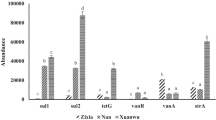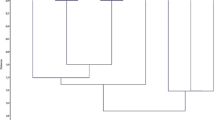Abstract
The present study examines the metal and antibiotic resistant bacteria in ice and water from lakes east and west of the Indian base camp (Maitri) in Antarctica. The isolates from western and eastern lakes showed distinct geographical differences in properties like metal resistance and enzyme expression. This may be attributed to high organic loading in the lakes on the west of Maitri. However, there was no marked geopraphical distinction in antibiotic resistance between the lakes. Bacteria from the lakes on the eastern side showed resistance to three or more metals including mercury while, those from the western were resistant to only 1–2 metals excluding mercury. Multiple enzyme expression was more pronounced in the lakes on the western side. On the eastern side multiple metal resistance was encountered in bacterial isolates associated with fewer enzyme expressions suggesting a “trade-off”. Thus these Antarctic isolates from the east trade their ability to express multiple enzymes for developing resistance to multiple metals including mercury.


Similar content being viewed by others
References
Alam SI, Singh L (2002) Proteolytic heterotrophic bacteria of cyanobacterial assemblage from Schirmacher oasis, Antarctica, capable of growing under extreme conditions. Curr Sci 83: 1000–1004
Barbieri P, Galassi G, Galli E (1989) Plasmid-encoded mercury resistance in a Pseudomonas stutzeri strain that degrades o-xylene. FEMS Microbiol Ecol 62: 375–384
Barbieri P, Bestetti G, Reniero D, Galli E (1996) Mercury resistance in aromatic compound degrading Pseudomonas strains. FEMS Microbiol Ecol 20: 185–194
Barkay T, Gillman M, Turner RR (1997) Effects of dissolved organic carbon and salinity on bioavailability of mercury. Appl Environ Microbiol 63: 4267–4271
Beja O, Koonin EV. Aravind L, Taylor LT, Seitz H, Stein JL, Bensen DC, Feldman RA, Swanson RV, DeLong EF (2002) Comparative genomic analysis of archaeal genotypic variants in a single population and in two different oceanic provinces. Appl Environ Microbiol 68: 335–345
Bohannan BJ, Kerr B, Jessup CM, Hughes JB, Sandvik G 2002 Trade-offs and coexistence in microbial microcosms. Antonie van Leeuwenhoek 81: 107–115
Bonner WN. 1984 Conservation and the Antarctic. In: Laws RM (ed) Antarctic Ecology, vol. 2, Academic Press, London, pp 821–850
Byerley JJ, Scharer JM (1992) Natural release of copper and zinc into the aquatic environment. Hydrometallurgy 30: 107–126
Canstein VH, Li Y, Timmis KN, Deckwer WD, Wagner-Dobler I (1999) Removal of mercury from chloralkali electrolysis wastewater by a mercury-resistant Pseudomonas putida strain. Appl Environ Microbiol 65: 5279–5284
Chandy JP (1999) Heavy metal tolerance in chromogenic and non-chromogenic marine bacteria from Arabian Gulf. Environ Monit Assess 59: 321–330
Chan KY, Dean ACR (1988) Effects of cadmium and lead on growth, respiration and enzyme activity of the marine bacterium Pseudomonas marina. Chemosphere 17: 597–607
De Flora S, Bennicelli C, Bagnasco M (1994) Genotoxicity of mercury compounds: a review. Mut Res 317: 57–79
De Souza MJBD, Nair S, Loka Bharathi PA, Chandramohan D (2006) Metal and antibiotic-resistance in psychrotrophic bacteria from Antarctic marine waters. Ecotoxicol 15: 379–384
Duxbury T (1986) Microbes and heavy metals: An ecological overview. Microbiol Sci 3: 330–333
Evans CW, Hills JM, Dickson JMJ (2000) Heavy metal pollution in Antarctica: a molecular ecotoxicological approach to exposure assessment. J Fish Biol 57: 8–19
Forstner U, Wittmann GTW (1979) Metal pollution in the aquatic environment. New York NY: Springer Verlag
Guhathakurta H, Kaviraj A (2000) Heavy metal concentration in water, sediment, shrimp (Penaeus monodon) and mullet (Liza parsia) in some brackish water ponds of Sunderban, India. Mar Pollut Bull 40: 914–920
Hermansson M, Jones GW, Kjelleberg S (1987) Frequency of antibiotic and heavy metal resistance, pigmentation and plasmids in bacteria of marine air-water interface. Appl Environ Microbiol 53: 2338–2342
Hideomi N, Ishikawa T, Yasunaga S, Kondo I, Mitsuhasi S (1977) Frequency of heavy-metal resistance in bacteria from inpatients in Japan. Nature 266: 165–167
Hoppe HG, Giesenhagen HC, Gocke K (1998) Changing patterns of bacterial substrate decomposition in a eutrophication gradient. Aquat Microb Ecol 15: 1–13
Ingole BS, Parulekar AH (1987) Microfauna of Schirmacher Oasis, Antarctica. 1. Water-moss communities 4 Indian Scientific Expedition to Antarctica Report. (Tech. Rep.; 4). DOD; 139–148
Ka JO, Holben WE, Tiedje JM (1994) Genetic and phenotypic diversity of 2,4-dichlorophenoxyacetic acid (2,4-D) degrading bacteria isolated from (2, 4-D) treated field soils. Appl Environ Microbiol 60: 1106–1115
Kim SD, Ma H, Allen HE, Cha DK (1999) Influence of dissolved organic matter on the toxicity of of copper to Ceriodaphnia dubia: effect of complezation kinetics. Environ Toxicol Chem 18: 2433–2437
Kobori H, Taga N (1978) Phosphatase activity and its role in the mineralization of organic phosphorus in coastal seawater. J Exp Mar Ecol 36: 23–39
Krishnamurti AJ, Nair VR. 1999 Concentration of metals in shrimps and crabs from Thane- Basin creek system Maharashtra. Ind J Mater Sci 28, 92–95
Loka Bharathi PA, Nair S, De Souza MJBD, Chandramohan D (2001) Assessment of viability in the bacterial standing stock of the Antarctic sea from the Indian side. Oceanologica Acta 24: 577–580
Mudryk Z, Donderski W, Skorczewski P, Walczak M (2000) Effect of some heavy metals on neustonic and planktonic bacteria isolated from the deep of Gdansk. Oceanol Stud 29: 89–99
Mueller HJ, Hinton J (1941) A protein-free medium for primary isolation of the Gonococcus and Meningococcus. Proceedings of the Society of Experimental Biological Medicine 48, 330–333
Nair S, Chandramohan D, Loka Bharathi PA (1992) Differential sensitivity of pigmented and non-pigmented marine bacteria to metals and antibiotics. Wat Res 26: 431–434
Nair S, Loka Bharathi PA, Chandramohan D (1993) Effect of Heavy metals on Bacillus sp. & Flavobacterium sp. Ecotoxicol 2: 220–229
Nygaerd T, Lie E, Roev N, Steinnes E (2001) Metal Dynamics in an Antarctic Food Chain. Mar-Pollut-Bull 42: 598–602
Oliver JD, Smith JF (1982) Intestinal microflora of Deep Sea Animal: A Taxonomic Study. Deep Sea Res 29: 785–794
Olson BH, Cayless SM, Ford S, Lester JN (1991) Toxic element contamination and the occurrence of mercury-resistant bacteria in mercury contaminated soil sediments and sludges. Arch Environ Contam Toxicol 20: 226–233
Petri G, Zauke GP (1993) Trace metals in crustaceans in the Antarctic Ocean. Ambio 22: 529–536
Pomeroy LR, Deibel D (1986) Temperature regulation of bacterial activity during the spring bloom in Newfoundland coastal waters. Science 223: 359–361
Ramaiah N, De J (2003) Unusual rise in mercury-resistant bacteria in coastal environs. Microb Ecol 45: 444–454
Rudolph E, Benninghof WS (1977) Competative and adaptive responses of invading versus indigenous biotas in Antarctica––A plea for organized monitoring. In: Clano GA (eds) Adaptations within Antarctic ecosystems, Smithsonian Institute, Washington DC, pp 1211–1225
Sabry SA, Ghozlan HA, Abou-Zeid DM (1997) Metal tolerance and antibiotic resisitance patterns of a bacterial population isolated from sea water. J Appl Microbiol 82, 245–252
Smibert RM, Krieg NR (1981) General characterization. In: Gerhardt P, Murray RGE, Costilow RN, Nester EW, Wood WA Krieg NR, Phillips GB (eds) Manual of methods for general bacteriology. American Society for microbiology, Washington DC p 524
Stolzenburg TR, Stanforth RR, Nichols DG (1986) Potential health effects of mercury in water supply wells. J Am Water Works Assoc 78: 45–48
Tilman D. 2000 Causes, consequences and ethics of biodiversity. Nature 405: 208–211
Traxler RW, Wood EM (1981) Multiple metal tolerance of bacterial isolates. Developments in industrial microbiology, Underkofler LA, Wulf ML, Flagstaff AZ (eds) (USA) 9–15 Aug. 1980 22, 521–528
Vaqué D, Pace ML, Findlay S, Lints D (1992) Fate of bacterial production in a heterotrophic ecosystem: grazing by protozoans and metazoans in the Hudson Estuary. Mar Ecol Prog Ser 89: 155–163
Vincent WF (1988) Microbial ecosystems of Antarctica. Cambridge University Press, Cambridge p 304
Walton DWH (1990) Colonisation of terrestrial habitats––organisms, opportunities and occurrence. In: Kerry KR, Hempel G (eds) Antarctic ecosystems, ecosystems, ecological change and conservation, Springer, Berlin, pp 51–60
Wylie JL, Currie DJ (1991) The relative importance of bacteria and algae as a food source for crustacean zooplankton. Limnol Oceanogr 36: 708–728
Yamamoto Y, Honda K, Tatsukawa R (1987) Heavy metal accumulation in Antarctic krill Euphausia superba. Proc-Nipr-Symp-Polar-Biol Natl.-Inst.-of-Polar-Research,-Tokyo-Japan 1, 198–204
Acknowledgements
PAL thanks the leader and members of the 13th Antarctic expedition for all the help rendered during the expedition. Dr. V.K. Dargalkar’s able assistance in the strategic collection of water samples from freshwater lakes in and around the Indian base camp–Maitri is acknowledged. NIO no. 4215.
Author information
Authors and Affiliations
Corresponding author
Rights and permissions
About this article
Cite this article
De Souza, MJ., Loka Bharathi, P.A., Nair, S. et al. “Trade-off” in Antarctic bacteria: limnetic psychrotrophs concede multiple enzyme expressions for multiple metal resistance. Biometals 20, 821–828 (2007). https://doi.org/10.1007/s10534-006-9045-8
Received:
Accepted:
Published:
Issue Date:
DOI: https://doi.org/10.1007/s10534-006-9045-8




